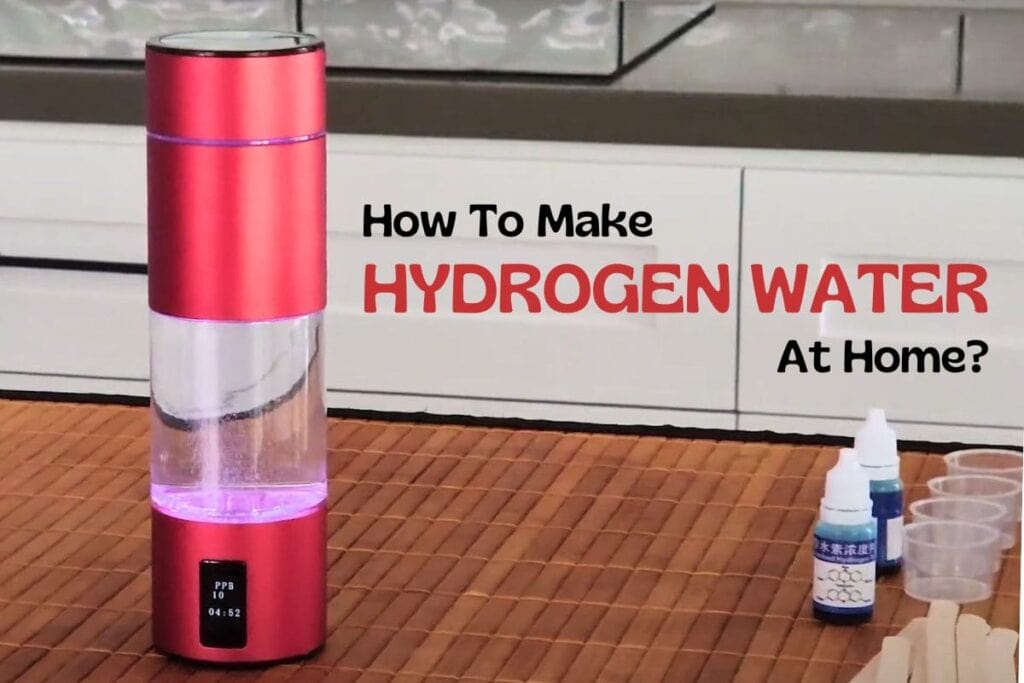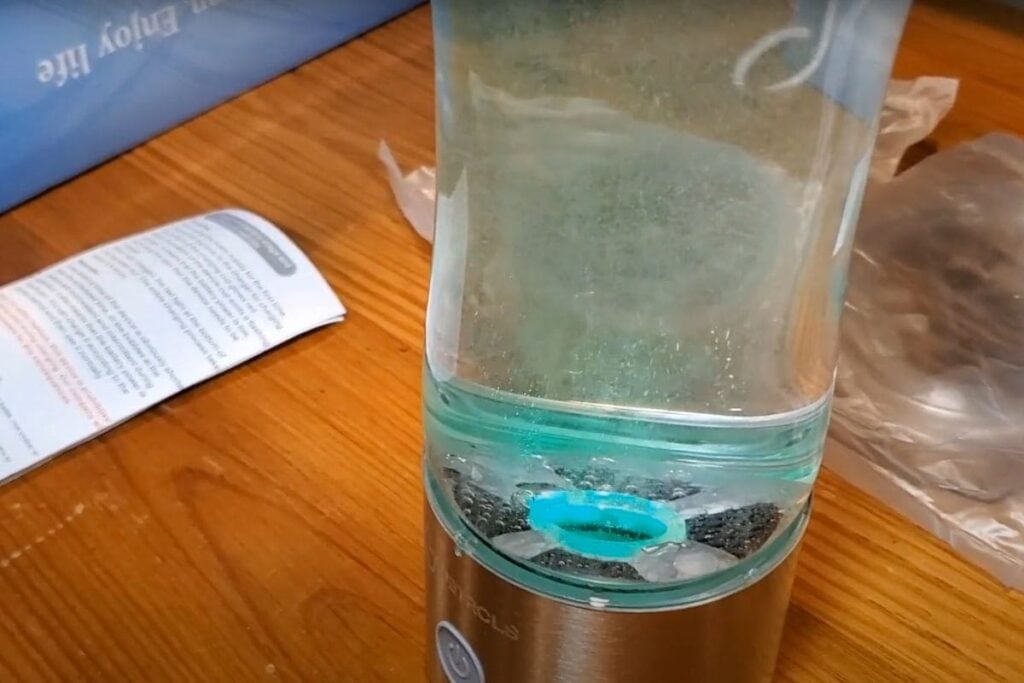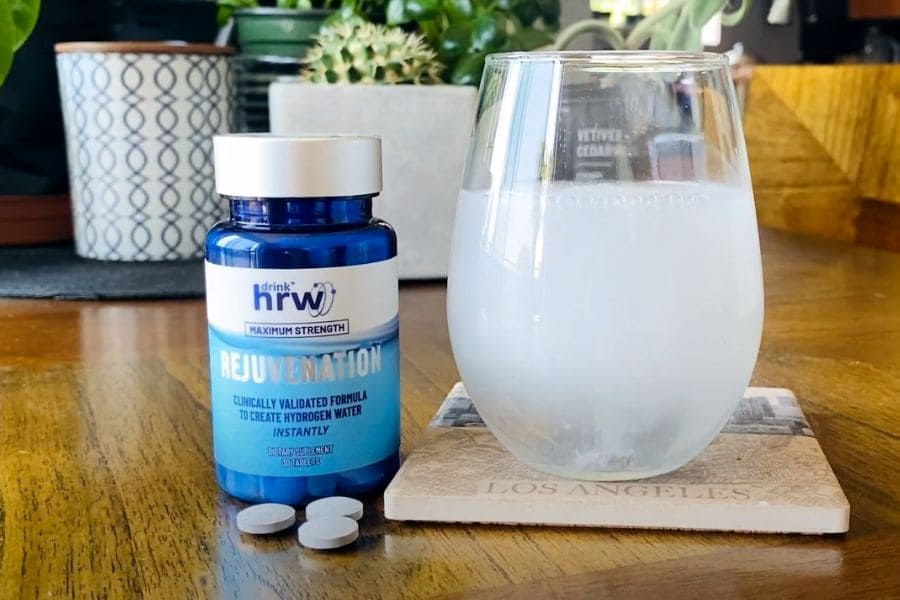When I decided to start drinking hydrogen water, I used to buy those cans from the supermarket. However, I realized that buying pouches or cans of H2-rich water is not quite cost-effective in the long term. That is when I started researching how to prepare hydrogen water for drinking at home.
In the process, I tested several hydrogen water generators, tablets, powder, and more, but only one solution turned out best in terms of QUALITY, SAFETY, and EFFECTIVENESS. So, if you are also looking for ways to make homemade hydro-water, let me share some solid ideas with you!

The Safest Ways To Make Hydrogen Water For Drinking At Home
Contrary to what you might think, making hydrogen water at home can actually be VERY EASY. Several methods are suitable for varying preferences, budgets, and conveniences. However, not all of them are equally effective or safe.
I have experimented enough to come across the best ways to prepare hydrogen-infused water at home. These are the SAFEST and MOST EFFECTIVE means of generating your own supply of H2 water from tap water. Let us take a look at them below.
1. Hydrogen Water Bottles
Using molecular hydrogen water bottles (or generators) is by far the easiest and most convenient way if you are looking for a sustainable means of including it in your daily routine.
Hydrogen water bottles work by using PEM or SPE technology to generate hydrogen water using normal tap water at your home. Proton Exchange Membrane (PEM) and Solid Poly Electrolytic (SPE) technologies are highly sophisticated systems used in the process of hydrogen infusion.
Using these technologies, hydrogen water bottles can swiftly generate pure H2-rich water that is perfectly suitable for drinking and devoid of residual pollutants such as CHLORINE or OZONE.

How To Generate Hydrogen Water With Those Bottles?
- Make sure your hydrogen water generator bottle is fully charged.
- Fill it up with regular tap water.
- Switch it ON, and let the process start and continue for about 3 to 4 minutes for hydrogen water with low concentration or 10 minutes for high concentration.
- Now your hydrogen water is ready. After switching it OFF, you can pour the water into a glass tumbler or drink from the bottle directly and drink.
I have written an in-depth article about the detailed process of using hydrogen water bottles. If you’re looking for more info, I am sure you will find it useful.
With tremendous popularity, hydrogen water generators are easily available for purchase both offline and online. These are available in different volumes from 300 ml to 1.5 liters to suit diverse requirements. On average, such bottles can generate about 1500 to 5000 ppb of total dissolved molecular hydrogen.
PROS
Very easy to use with convenient maintenance.
Portable. Buy once and keep using it repeatedly.
Generates pure and safe hydrogen water for drinking.
Cost-effective.
Easy cleaning and maintenance.
CONS
Generated hydrogen concentration may vary drastically from one bottle to another.
In the course of my experiments with molecular H2 water, I have tried and tested more than 20 such bottles. While the one from the brand Echo Go+, recommended by biologist Gary Brecka, did not quite impress me with its performance, I recommend using hydrogen water bottles from brands such as Level Up Way and Piurify, which performed much better.
2. Hydrogen Tablets And Powder
Before buying hydrogen water generator bottles, I also tried using different powders and tablets. I found that these are excellent for those who are always on the go, and you can buy these tablets at a very affordable price point. However, it might not be a feasible option for you in the long run, as it happened in my case.

Hydrogen-producing tablets and powder can easily dissolve in water, undergoing a rapid effervescent chemical reaction that releases molecular H2.
Here Is How To Use Them At Home
- Take an airtight bottle and fill it with regular tap water.
- Add the recommended quantity of hydrogen powder or pop in a tablet.
- Wait for a few minutes until the powder or tablet completely dissolves in water, producing hydrogen bubbles.
- Shake the bottle to evenly distribute the gas evenly.
- Your hydrogen water is ready for consumption immediately.
Powders and tablets generally produce the highest concentration of molecular hydrogen gas. However, I found that the concentration DIFFERS depending on the size of the tablet or the scoop size of the powder and the constituent ingredients.
As a result, the concentration of the dissolved hydrogen gas also varies, influencing the taste of the resultant water. In higher concentrations, the resultant water might taste slightly caustic.
PROS
Easy to use.
Economical for short-term use.
Highly portable.
CONS
Not cost-effective for long-term use.
Molecular hydrogen concentration varies.
The taste of water changes with a higher concentration of hydrogen gas.
3. Non-electric Water Ionizers
Electric water ionizers are massive, bulky machines and are generally very risky and inconvenient for domestic use. But there was a time, I bought a small non-electric water ionizer machine at my home, which is basically a filter and an ionizer in a single unit. I got it primarily because it was compact and budget-friendly, and I wanted to try it out.
However, I realized that it involved too many hassles for everyday long-term use and DID NOT even come close to hydrogen water bottles in terms of convenience. Nevertheless, I wanted to share my thoughts on these non-electric water ionizer filters with you.
Non-electric water ionizers use materials like ceramic and tourmaline crystals to mimic natural environments that produce hydrogen-rich water. When tap water flows through these materials, it produces small amounts of molecular H2 that INFUSES the water. These can also filter tap water and produce alkaline minerals such as magnesium, calcium, and potassium through the process of ionization.
PROS
Budget-friendly.
Produces clean and mineral-rich hydrogen water.
Can also produce alkaline water.
CONS
Ineffective for long-term use.
Produces very minute quantities of molecular hydrogen gas.
Difficult to use.
Also Read: Hydrogen Water vs Alkaline Water
Homemade Methods To Generate Hydrogen Water But Not Suitable for Consumption
Apart from the methods described above, you can generate H2 water in several other ways, as mentioned below. However, it is crucial to note that molecular hydrogen water yielded by these methods is not generally suitable for drinking. So, while you can try them out at your home, I DO NOT recommend consuming the hydrogen water obtained by these methods.
A. Magnesium Sticks
Producing hydrogen-rich water is very easy using magnesium sticks. When magnesium comes into contact with tap water, it reacts instantly, generating molecular hydrogen. You can store magnesium sticks for a long time since they have a reasonably long shelf life. And you can buy them at a very affordable price point as well.
However, there are some caveats to employing this method for hydrogen water generation at home. Here is why I don’t recommend it:
- No Filtration Capability: Magnesium sticks might be effective in generating hydrogen, but they also produce harmful byproducts. Tap water generally contains various impurities, which have a high chance of reacting with magnesium, producing toxins that hamper the quality of hydrogen water produced and also impact your health. As such, the majority of manufacturers recommend these to be used in a bottle of purified and filtered water.
- Inconsistent levels of hydrogen concentration: The concentration of molecular hydrogen produced by magnesium sticks can be inconsistent. As such, the water might taste weird. Besides, we do not know how long the same magnesium stick can be reused to produce sufficient levels of hydrogen gas.
B. DIY Electrolysis
Electrolysis is the process that involves breaking water molecules into their constituent hydrogen and oxygen atoms by passing an electric current through water. Trying out DIY electrolysis at your home can be an interesting experiment; I know because I tried! However, the output (or yield) is not going to be worth your effort or time.
Why you ask? Well, here are the reasons:
- Electrical Hazard: Your DIY electrolysis kit will need to be properly insulated or grounded otherwise it can involve risks of electric shock when you are working near it.
- Complicated Process: If you wish to carry out electrolysis for homemade hydrogen water generation, you will first need a proper setup. The process is not simple at all because it does not end with splitting water into hydrogen and oxygen – the hydrogen gas produced will again have to be reutilized. Since H2 is lighter than air, it tends to dissipate swiftly as soon as it is released. That requires additional setup to prevent the dispersal of molecular hydrogen gas before it can be infused with water.
- Fire Hazards: You have to make sure that no source of heat or energy is anywhere nearby since hydrogen is a highly flammable gas. It can burst into flames from the slightest amount of heat or electrical spark, resulting in explosion or fire hazards.
- Insufficient Hydrogen Concentration: Even if you manage to create a DIY electrolysis setup at home, the concentration of hydrogen produced will be insufficient to generate water.
- Chemical hazards: If the water used in the electrolyte contains contaminants, electrolysis might generate toxic chemicals, causing skin irritation or other health hazards.
C. Baking Soda
Generating hydrogen-rich water using baking soda (sodium bicarbonate) is another very affordable and easy way to try at home. When sodium bicarbonate reacts with water, it leads to the formation of hydrogen as well as carbon dioxide. This chemical reaction is exothermic, meaning it generates a significant amount of heat. Using baking soda not only generates molecular hydrogen gas but also makes the resultant water slightly alkaline.
However, I would not use baking soda to prepare hydrogen water anymore; here is why:
- Ineffective Process: The first time I tried preparing H2-infused water using baking soda, it felt like a fun science experiment we did in school! However, the method was ineffective in producing the right concentration of hydrogen because it was difficult to ascertain the perfect amount of baking soda that generates just the right level of hydrogen concentration that is beneficial for you.
- Weird Taste: The hydrogen water tasted quite bitter and somewhat strange due to its alkalinity. This odd taste was pretty much disagreeable to my taste buds.
- High Sodium Content: Using large quantities of baking soda in the preparation of hydrogen-infused water is not at all recommended. This is because baking soda is very high in sodium content, so using it for the long term can have serious, adverse effects on our health.
But, Can You Also Prepare Hydrogen Water Using Hydrogen Peroxide (H2O2)?
A well-known disinfectant chemical used for water treatment, hydrogen peroxide, contains two atoms of hydrogen and two atoms of oxygen. Owing to its H2-rich chemical structure, I have often wondered whether we can create hydrogen water using hydrogen peroxide.
Though I have never tried H2O2 for hydrogen water generation myself, applying my knowledge of inorganic chemistry, I understand why this is impossible. To my knowledge, we cannot derive hydrogen water indirectly from hydrogen peroxide. Here is the chemical reaction:
2H2O2 → 2H2O + O2↑
Hydrogen peroxide dissolves QUICKLY in water, disintegrating into molecules of water and oxygen gas, and does not leave any byproducts. So, it simply adds more molecules of water, which can then be treated using any of the methods described above to generate hydrogen-rich water.
However, it gives off a sharp, acidic, or pungent smell. In very high concentrations, H2O2 can also trigger a burning sensation or irritation in our eyes and skin, causing permanent damage and even death if not handled with extreme caution. Simply inhaling fumes of hydrogen peroxide can also be highly detrimental to our health.
So, it is not at all recommended to use hydrogen peroxide to prepare hydrogen water at home. In fact, much better options are out there!
Key Takeaways
Buying an H2 water bottle is the easiest, safest, and most cost-effective method of preparing hydrogen water at home.
Hydrogen water bottles are easily available in different sizes and price ranges.
Bulky electric ionizer filters require hefty investment and are apt for commercial use.
Using hydrogen tablets and powder at home is easy but not pocket-friendly in the long run.
Using baking soda, magnesium sticks, and DIY electrolysis might be convenient but not recommended due to health safety concerns.

